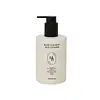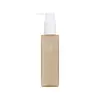What's inside
What's inside
 Key Ingredients
Key Ingredients

 Benefits
Benefits

 Concerns
Concerns

 Ingredients Side-by-side
Ingredients Side-by-side

Citrus Junos Fruit Water
MaskingWater
Skin ConditioningVigna Radiata Seed Extract
Skin ConditioningGlycerin
HumectantSimmondsia Chinensis Seed Oil
EmollientPropylene Glycol Dicaprylate/Dicaprate
EmollientGlycine Soja Seed Extract
Skin ConditioningGlycine Soja Oil
EmollientDecyl Glucoside
CleansingBetaine
HumectantPolyglyceryl-3 Methylglucose Distearate
EmulsifyingCetearyl Alcohol
EmollientButylene Glycol
HumectantGlyceryl Stearate
EmollientSchisandra Chinensis Fruit Extract
Skin ConditioningArtemisia Princeps Leaf Water
MaskingCamellia Sinensis Leaf Water
MaskingGlycine Soja Peptide
Skin ConditioningAvena Sativa Peptide
Skin ConditioningGlycine Max Polypeptide
Skin ConditioningTriticum Aestivum Peptide
Skin ConditioningLactobacillus Ferment
Skin ConditioningLactococcus Ferment
Skin ConditioningRehmannia Glutinosa Root Extract
Skin ConditioningCornus Officinalis Fruit Extract
Skin ConditioningAlisma Orientale Tuber Extract
Skin ConditioningCoptis Japonica Root Extract
Skin ConditioningDioscorea Japonica Root Extract
Skin ConditioningPaeonia Suffruticosa Root Extract
Skin ProtectingSmilax Glabra Root Extract
Skin ConditioningArtemisia Annua Extract
MaskingLepidium Meyenii Root Extract
Skin ConditioningOryza Sativa Extract
AbsorbentStellaria Media Extract
Skin ConditioningAvena Sativa Meal Extract
SoothingHydrolyzed Vegetable Protein
Skin ConditioningGlycoproteins
Skin ConditioningMaltodextrin
AbsorbentTromethamine
Buffering1,2-Hexanediol
Skin ConditioningXanthan Gum
EmulsifyingSodium Stearoyl Glutamate
CleansingPentylene Glycol
Skin ConditioningAcrylates/C10-30 Alkyl Acrylate Crosspolymer
Emulsion StabilisingPolyquaternium-51
Skin ConditioningPropanediol
SolventCyanocobalamin
Skin ConditioningSorbitan Stearate
EmulsifyingHydroxyacetophenone
AntioxidantEthylhexylglycerin
Skin ConditioningPalmitic Acid
EmollientStearic Acid
CleansingDisodium EDTA
Citrus Junos Fruit Water, Water, Vigna Radiata Seed Extract, Glycerin, Simmondsia Chinensis Seed Oil, Propylene Glycol Dicaprylate/Dicaprate, Glycine Soja Seed Extract, Glycine Soja Oil, Decyl Glucoside, Betaine, Polyglyceryl-3 Methylglucose Distearate, Cetearyl Alcohol, Butylene Glycol, Glyceryl Stearate, Schisandra Chinensis Fruit Extract, Artemisia Princeps Leaf Water, Camellia Sinensis Leaf Water, Glycine Soja Peptide, Avena Sativa Peptide, Glycine Max Polypeptide, Triticum Aestivum Peptide, Lactobacillus Ferment, Lactococcus Ferment, Rehmannia Glutinosa Root Extract, Cornus Officinalis Fruit Extract, Alisma Orientale Tuber Extract, Coptis Japonica Root Extract, Dioscorea Japonica Root Extract, Paeonia Suffruticosa Root Extract, Smilax Glabra Root Extract, Artemisia Annua Extract, Lepidium Meyenii Root Extract, Oryza Sativa Extract, Stellaria Media Extract, Avena Sativa Meal Extract, Hydrolyzed Vegetable Protein, Glycoproteins, Maltodextrin, Tromethamine, 1,2-Hexanediol, Xanthan Gum, Sodium Stearoyl Glutamate, Pentylene Glycol, Acrylates/C10-30 Alkyl Acrylate Crosspolymer, Polyquaternium-51, Propanediol, Cyanocobalamin, Sorbitan Stearate, Hydroxyacetophenone, Ethylhexylglycerin, Palmitic Acid, Stearic Acid, Disodium EDTA
Ethylhexyl Palmitate
EmollientTriethylhexanoin
MaskingGlycerin
HumectantCoco-Caprylate/Caprate
EmollientWater
Skin ConditioningPolyglyceryl-10 Myristate
Skin ConditioningPropylene Glycol Laurate
Skin ConditioningKaolin
AbrasiveFicus Carica Fruit Extract
HumectantCentella Asiatica Extract
CleansingCamellia Sinensis Leaf Extract
AntimicrobialHelianthus Annuus Seed Oil
EmollientSimmondsia Chinensis Seed Oil
EmollientHydrogenated Lecithin
EmulsifyingCaprylic/Capric Triglyceride
MaskingSucrose Stearate
Emollient1,2-Hexanediol
Skin ConditioningSucrose Laurate
EmollientSucrose Myristate
EmollientPanthenol
Skin ConditioningZea Mays Germ Oil
EmollientPentaerythrityl Tetra-Di-T-Butyl Hydroxyhydrocinnamate
AntioxidantButylene Glycol
HumectantSucrose
HumectantHyaluronic Acid
HumectantSaccharomyces Ferment Filtrate
HumectantCeramide NP
Skin ConditioningCholesterol
EmollientCitric Acid
BufferingEthylhexyl Palmitate, Triethylhexanoin, Glycerin, Coco-Caprylate/Caprate, Water, Polyglyceryl-10 Myristate, Propylene Glycol Laurate, Kaolin, Ficus Carica Fruit Extract, Centella Asiatica Extract, Camellia Sinensis Leaf Extract, Helianthus Annuus Seed Oil, Simmondsia Chinensis Seed Oil, Hydrogenated Lecithin, Caprylic/Capric Triglyceride, Sucrose Stearate, 1,2-Hexanediol, Sucrose Laurate, Sucrose Myristate, Panthenol, Zea Mays Germ Oil, Pentaerythrityl Tetra-Di-T-Butyl Hydroxyhydrocinnamate, Butylene Glycol, Sucrose, Hyaluronic Acid, Saccharomyces Ferment Filtrate, Ceramide NP, Cholesterol, Citric Acid
Ingredients Explained
These ingredients are found in both products.
Ingredients higher up in an ingredient list are typically present in a larger amount.
1,2-Hexanediol is a synthetic liquid and another multi-functional powerhouse.
It is a:
- Humectant, drawing moisture into the skin
- Emollient, helping to soften skin
- Solvent, dispersing and stabilizing formulas
- Preservative booster, enhancing the antimicrobial activity of other preservatives
Butylene Glycol (or BG) is used within cosmetic products for a few different reasons:
Overall, Butylene Glycol is a safe and well-rounded ingredient that works well with other ingredients.
Though this ingredient works well with most skin types, some people with sensitive skin may experience a reaction such as allergic rashes, closed comedones, or itchiness.
Learn more about Butylene GlycolGlycerin is already naturally found in your skin. It helps moisturize and protect your skin.
A study from 2016 found glycerin to be more effective as a humectant than AHAs and hyaluronic acid.
As a humectant, it helps the skin stay hydrated by pulling moisture to your skin. The low molecular weight of glycerin allows it to pull moisture into the deeper layers of your skin.
Hydrated skin improves your skin barrier; Your skin barrier helps protect against irritants and bacteria.
Glycerin has also been found to have antimicrobial and antiviral properties. Due to these properties, glycerin is often used in wound and burn treatments.
In cosmetics, glycerin is usually derived from plants such as soybean or palm. However, it can also be sourced from animals, such as tallow or animal fat.
This ingredient is organic, colorless, odorless, and non-toxic.
Glycerin is the name for this ingredient in American English. British English uses Glycerol/Glycerine.
Learn more about GlycerinThis oil comes from the seeds of the desert shrub called Jojoba. It is more commonly known as jojoba oil, a non-comedogenic oil.
Jojoba oil does not contain fragrance and has many fatty-acids, making it a great soothing ingredient.
It also contains Vitamin E, a great moisturizing ingredient. Vitamin E is also an antioxidant and protects your skin against oxidative damage.
This ingredient humectant properties, meaning it helps draw moisture from the air. This helps keep your skin hydrated.
While jojoba has antibacterial properties, it is only able to kill some strains of bacteria.
Studies also show it helps in wound healing. In fact, Indigenous cultures have used jojoba as a moisturizer and to help treat burns for centuries.
Fun fact: Jojoba oil similar to natural human skin sebum, so it has a great effect on dry skin. It is also promising with helping to regulate sebum production.
Due to its fatty acid content, Jojoba oil may not be fungal acne safe. We recommend speaking with a professional if you have any concerns.
Learn more about Simmondsia Chinensis Seed OilWater. It's the most common cosmetic ingredient of all. You'll usually see it at the top of ingredient lists, meaning that it makes up the largest part of the product.
So why is it so popular? Water most often acts as a solvent - this means that it helps dissolve other ingredients into the formulation.
You'll also recognize water as that liquid we all need to stay alive. If you see this, drink a glass of water. Stay hydrated!
Learn more about Water